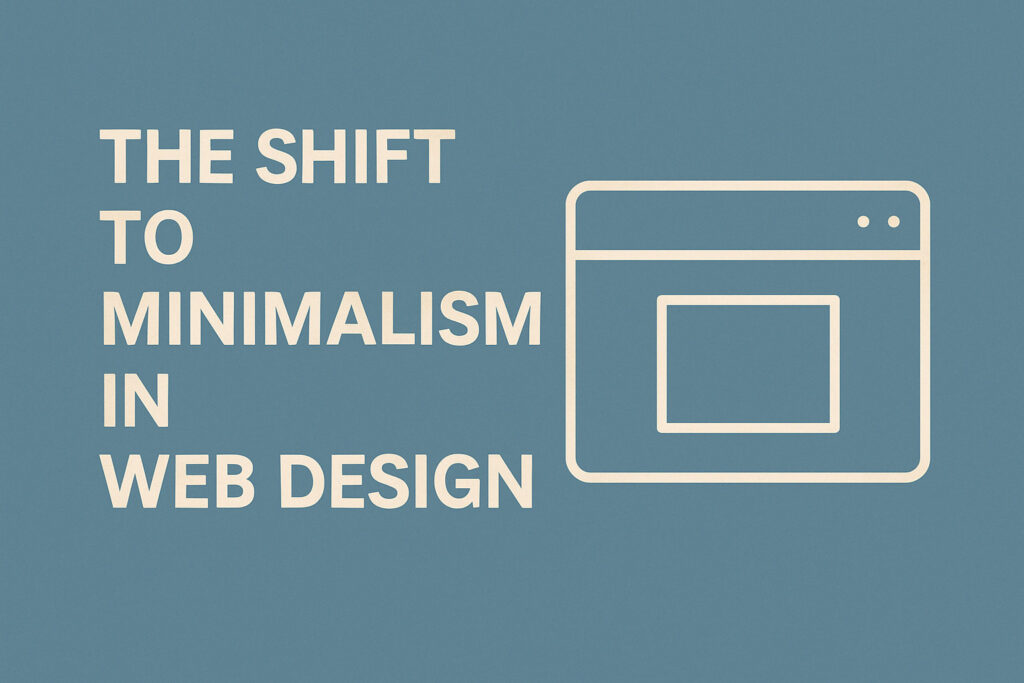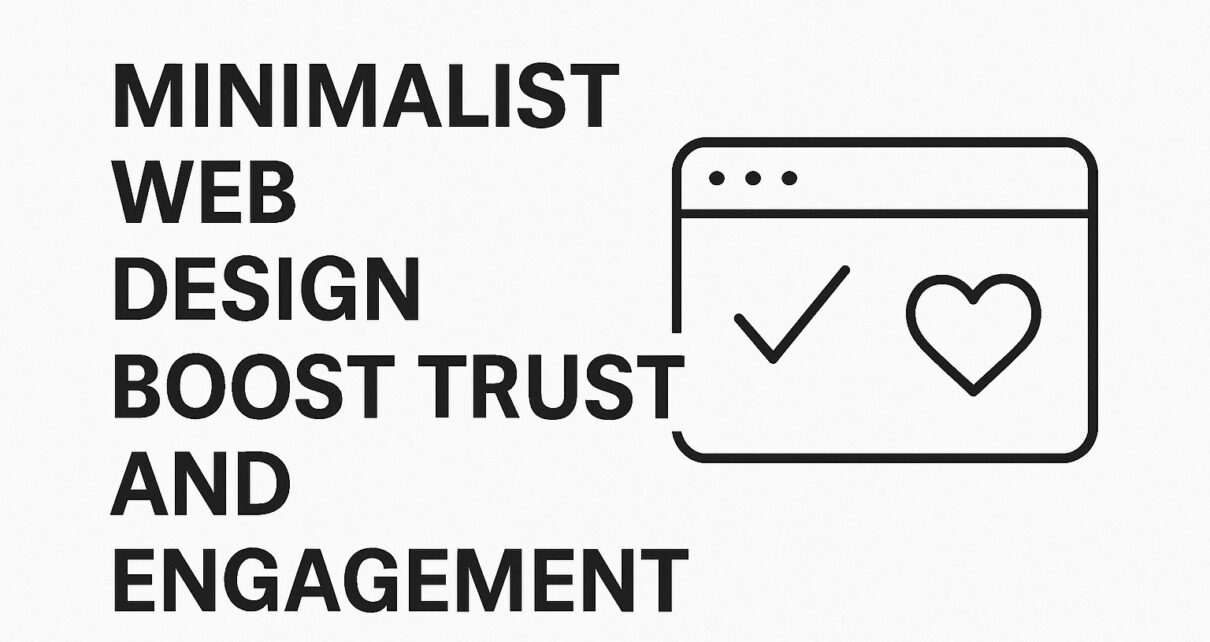Imagine landing on a website that feels effortless. The layout is clean, the navigation is intuitive, and every element serves a purpose, reflecting the brand’s purpose. The web analytics industry plays a significant role in shaping these trends and providing insights that drive design decisions and enhance user engagement.
You immediately trust the brand behind it. That’s the power of minimalist web design. It creates a sense of clarity, confidence, and connection without overwhelming users.
Minimalism is about how a website makes users feel. A cluttered, chaotic design can create frustration, while a well-structured, intentional layout promotes trust, engagement, and brand loyalty.
This article explores how minimalist design influences user perception, why it’s so effective in branding, and how to avoid the pitfalls of oversimplification. Let’s get started!
Get Introduced With Minimalist Web Design

At its core, minimalist web design is about focusing on what truly matters. A dedicated web design team ensures that these principles are effectively implemented, resulting in a cohesive and functional design.
It involves stripping away the superfluous and honing in on the essential features that make a website functional and user-friendly. Here are the key principles that define minimalist web design:
- Simplicity: The hallmark of minimalist web design is its simplicity. This means using simple shapes, clean lines, and a limited color palette to create a design that is free from clutter. By eliminating unnecessary elements, the design becomes focused and impactful.
- Clarity: A minimalist website is designed to be easy to understand and navigate. This involves using clear and concise language, intuitive navigation, and a well-defined visual hierarchy. The goal is to ensure that users can find what they are looking for without any confusion.
- Functionality: Every element in a minimalist design serves a purpose. This means that all design elements are carefully chosen to enhance the overall user experience. Unnecessary elements that do not contribute to the functionality of the website are eliminated, resulting in a streamlined and efficient design.
By adhering to these principles, minimalist web design creates a user experience that is both engaging and effective, making it a popular choice among the latest web design trends.
The Shift to Minimalism in Web Design

Web design has come a long way from the cluttered, noisy layouts of the early 2000s. A skilled web design team is crucial in adapting to these changes, ensuring that modern web design meets both aesthetic and functional needs.
Back then, pop-ups, flashing banners, and excessive menu options fought for user attention. Websites felt like overwhelming digital billboards.
Then came the shift, driven by companies like Apple, Google, and Twitter, which embraced clean, focused interfaces. This web design trend towards minimalism was driven by several factors:
- Users wanted speed and efficiency. A minimalist design loads faster and eliminates distractions.
- Cognitive overload was real, people got tired of sorting through too much information.
- Mobile devices changed everything. Responsive, touch-friendly layouts became essential.
How Big Brands Use Minimalism for User Engagement
Simplicity Sells Trust: Many of today’s most successful websites are minimalist because simplicity enhances trust and reinforces brand identity.
Role of Web Analytics: Web analytics provides data and insights that help brands refine minimalist designs to improve user engagement.
YouTube’s Evolution:
- Earlier designs were cluttered with sidebars and recommendations.
- Now, the focus is on large video thumbnails, clear text, and intuitive navigation to enhance user experience.
Twitter’s Transformation:
- Cluttered interfaces and complex buttons were replaced with simplified layouts and improved readability, leading to higher engagement.
Airbnb’s Refined Interface:
- Transitioned to a minimalistic homepage with fewer distractions.
- The new design increased bookings and improved user retention.
Beyond Looks: Minimalism as a Trust-Building Strategy
Minimalist design shapes how users feel. A well-structured website:
- Feels transparent – A clutter-free layout suggests honesty and professionalism.
- Reduces stress – Users aren’t bombarded with choices, making decision-making easier.
- Builds credibility – The absence of distractions makes the content feel authoritative.
A skilled web design team ensures that every element of the design contributes to building trust and credibility.
Whitespace and Negative Space as Trust Elements
Whitespace and negative space are fundamental components of minimalist web design. Whitespace refers to the empty space between design elements, while negative space is the empty space within design elements.
A web design team plays a crucial role in strategically using whitespace and negative space to enhance the overall design. Both play a crucial role in creating a clean and uncluttered design that is easy to navigate.
The strategic use of whitespace and negative space not only enhances the visual appeal of a website but also builds trust and credibility. A website with ample whitespace and negative space conveys a sense of openness and transparency.
This can make visitors feel comfortable and confident in engaging with the site, as it suggests that the brand has nothing to hide.
Moreover, whitespace and negative space help to direct the user’s attention to the important elements on the page.
By reducing visual clutter, these design elements make it easier for users to focus on the content that matters, thereby improving the overall user experience.
The Hidden Psychology of Minimalist Design
Why Simplicity Makes People Trust You
Minimalism eliminates that struggle. A well-designed website feels effortless because it follows these core principles:
- Whitespace as a Trust Signal → breathing room = focus on important content.
- Guided Attention → Clear visual hierarchy directs users to key actions.
- Predictability = Comfort → Familiar layouts create a sense of ease and reliability.
Minimalism in UX: How Less is More
Minimalist UX reduces friction between users and their goals. A web design team plays a crucial role in reducing friction and enhancing user experience through minimalist design. Consider these benefits:
- Visual Hierarchy Simplifies Choices → Users instantly know where to click.
- Faster Navigation = Higher Engagement → Less clutter means users get to their destination without confusion.
- The Paradox of Choice → Too many options overwhelm users. Minimalism creates clarity and confidence in decision-making.
A perfect example? Google’s homepage. The single search bar, empty space, and intuitive simplicity keep users focused on one action: searching.
Color and Typography in Minimalist Design
Color and typography are also key elements in minimalist web design. A web design team carefully selects colors and typography to ensure consistency and visual appeal. A minimalist website typically employs a limited color palette and a simple typography scheme.
This approach not only contributes to a clean and uncluttered design but also helps to create a sense of consistency and cohesion throughout the site.
The use of a limited color palette, often restricted to two or three colors, ensures that the design remains focused and visually appealing. These colors are carefully chosen to reflect the brand’s identity and evoke the desired emotional response from users.
Similarly, the typography in minimalist web design is kept simple. Typically, one or two fonts are used to maintain a cohesive look and feel. The choice of fonts is crucial, as it can significantly impact the readability and overall aesthetic of the website.
The Emotional Impact of Minimalist Design on Brand Perception
A website’s design goes beyond sharing information; it influences how users perceive a brand. Minimalist design, when executed well, conveys confidence, exclusivity, and professionalism. Many iconic brands use simplicity to communicate a clear message: “Our quality speaks for itself.”
Minimalism is about creating an emotional connection between users and a brand. The way a website is designed can influence whether users trust a company, feel intrigued, or disengage entirely.
Let’s explore how minimalist web design shapes branding and perception.
Minimalism as a Luxury Signal for Brand Identity
Ever noticed how high-end brands rarely clutter their web pages?
- Apple’s product pages → Focused, sleek, and premium.
- Tesla’s website → Minimalist, with high-quality visuals and clear calls to action.
- Muji’s branding → Clean typography and neutral colors reinforce simplicity as sophistication.
A web design team ensures that every element of the design reflects the brand’s luxury and sophistication.
Minimalism creates an impression of exclusivity. When a brand eliminates clutter, it signals confidence, it doesn’t need distractions to convince users of its value.
The Psychology of Consistency
Trust is built through consistency. A web design team ensures that colors, fonts, and layouts are consistent across all pages, reinforcing brand reliability. A minimalist website reinforces brand reliability by:
- Keeping colors, fonts, and layouts uniform across all pages.
- Avoiding visual noise that could confuse or overwhelm users.
- Providing a predictable, seamless experience that feels professional.
How Minimalist Design Tells a Story
Minimalist brands speak through design rather than excessive text. A web design team uses color choices, whitespace, and micro-interactions to create a cohesive and engaging brand story. Consider how:
- Color choices evoke emotion → Blue = trust (LinkedIn), Red = urgency (Netflix, YouTube).
- Whitespace creates mood → More space = calm, focused interaction.
- Microinteractions enhance engagement → Hover effects and animations add warmth without clutter.
Why Users Respond Emotionally to Minimalist Design
The minimalist web design trend impacts how users feel while navigating. A well-executed minimalist design creates a sense of calm, control, and satisfaction, making users more likely to trust the website and stay engaged.
The web analytics industry provides insights that help designers create emotionally engaging minimalist designs. But why does this happen?
The answer lies in human psychology. Studies show that too much choice leads to stress, while a structured, predictable environment helps people feel at ease. When websites are designed with balance, space, and clarity, users experience a subconscious sense of relief.
When Minimalism Goes Wrong: How Simplicity Can Feel Cold or Confusing
While minimalism is effective, it has its risks. If taken to the extreme, it can make a website feel cold, impersonal, or even frustrating. A great minimalist design must balance simplicity with warmth and usability.
The web analytics industry provides data-driven insights that help designers avoid the pitfalls of minimalism and enhance website performance.
Too often, brands remove so much that users feel lost, disconnected, or confused. Let’s explore when minimalism goes too far and how to fix it. Webtrends Optimize can help avoid these pitfalls by providing data-driven insights and testing solutions to enhance website performance.
Practical Strategies: Making Minimalism Work for Your Brand

Minimalism is very effective when it is intentional. A great minimalist website strategically designed to guide users, create engagement, and reinforce trust. So, how do you make sure your minimalist site is functional, engaging, and emotionally compelling?
The web analytics industry provides customizable tracking and insights that help brands measure the effectiveness of their minimalist designs. Utilizing customizable tracking can help you measure unique metrics specific to your needs and enhance your overall digital marketing strategy.
How to Keep Minimalism Engaging
- Whitespace as a Guide: Directs focus without feeling empty, supported by effective data collection to understand user behavior. A web design team uses whitespace, typography, and subtle UI enhancements to keep minimalist designs engaging and user-friendly.
- Typography that Builds Trust: Serif fonts feel timeless, and sans-serif fonts feel modern.
- Subtle UI Enhancements: Microinteractions add delight.
Micro-Interactions and Animations
Micro-interactions are the unsung heroes of web design. They offer subtle yet powerful feedback that enhances the overall user experience. These small animations can highlight important elements, provide real-time feedback on user actions, and create a sense of responsiveness that makes the website feel alive and interactive.
For example, when a user completes a form and sees a checkmark animation confirming their submission, it provides a sense of accomplishment and clarity. Similarly, a loading spinner can reassure users that their request is being processed, reducing frustration and uncertainty.
By integrating these micro-interactions, web designers can create an intuitive and user-friendly experience that keeps users engaged and satisfied.
Minimalism Is the Future
Minimalist web design is about making a website simple, clear, and easy to use. It builds trust and keeps users interested by focusing only on what’s important. Small animations and effects can make the site feel more interactive and guide users smoothly.
Good minimalist design doesn’t mean having less, but making sure every element has a purpose. It helps users navigate easily and makes the site look clean and professional. Webtrends Analytics tracks how people use the site and helps improve its performance.
If you want a simple, engaging website, check out Graphedge to get started.



